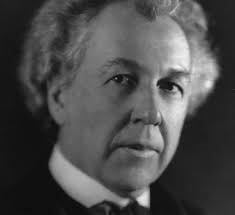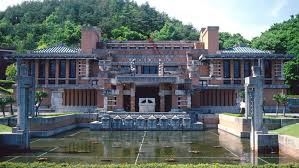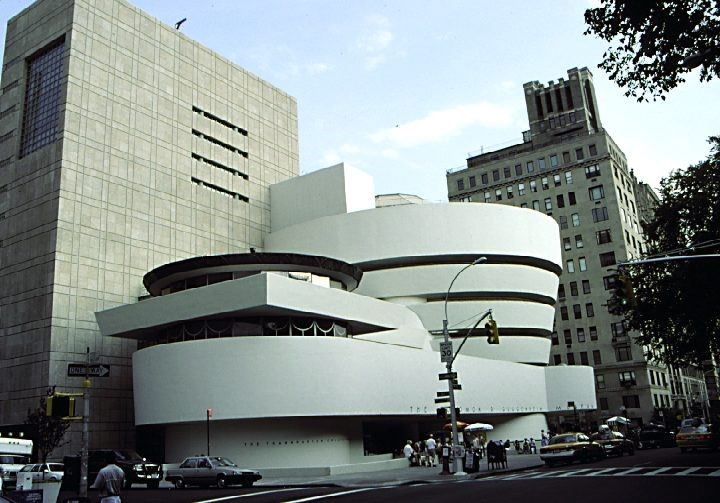One man, a self-proclaimed, imaginative, clever, and extraordinary man, who changed the world one structure at a time, a hero. Frank Lloyd Wright was a legendary face in the realm of architecture, designing and reimagining more than a thousand structures in his lifetime. Frank Lloyd Wright was born in Richland Center, Wisconsin, June 8, 1867, died April 9, 1959. He grew up in a rural part of the United States, and tried to maintain a decent education in Chicago. But he knew that as he got older, he would be an architect. As an architect, Wright was looking for ways to change the modern trends. He believed in a style he called “Organic Architecture,” which is designing a structure to have, or look like, the elements found in the nature around it. At the Guggenheim Museum in New York, a lot of his work and projects are displayed for everyone to see the impact he has had on the world. Wright has spoken at many public events, written many books and autobiographies, and there are still remnants of him in today’s modern society. A hero must possess the abilities of leaving an impact and influence from their work and to others and showing a good personality that others might aspire to be. Having an impact means to leave a mark on the world that will stay there forever. A successful hero will never die. By portraying one’s self to have the qualities of an exceptional personality, people will aim to have that personality. A hero influences the good in others. Frank Lloyd Wright’s passion and brilliance in the art of architecture truly earn him the title of a hero through his impact and influence towards the world and from a personality that shines.
 A picture of Frank Lloyd Wright.biography.comThroughout Wright’s years of hard work and dedication, he pursued his utmost passion in life, and became a world-renowned inspiration for everyone, for those who had an interest in architecture, and even those who didn’t. He was able to reach out and touch the hearts of people who lived on the other side of the world. The actions of Wright were always noticed, even in places Wright wouldn’t have even thought they knew who he was:
A picture of Frank Lloyd Wright.biography.comThroughout Wright’s years of hard work and dedication, he pursued his utmost passion in life, and became a world-renowned inspiration for everyone, for those who had an interest in architecture, and even those who didn’t. He was able to reach out and touch the hearts of people who lived on the other side of the world. The actions of Wright were always noticed, even in places Wright wouldn’t have even thought they knew who he was:
Thereupon, I spent six years on studies of earthquake conditions. It never left my consciousness. And we solved the problem of the menace of the quake by concluding that rigidity couldn't be the answer, and that flexibility and resiliency must be the answer. So we built [a] building [that] could flex and return to normal. And it did withstand the great quakes. But also for the first time in the history of Japan a foreigner had taken off his hat to her culture and tried to build with Western technology without losing what was precious and beautiful in her own culture. The Imperial Hotel had not only to withstand the earthquake but also to be worthy to stand without annoyance and insolence in Japan. (Biography in Context, “Frank Lloyd Wright Talks of His Art”)
Wright has inspired foreign countries such as Germany and Japan, but more importantly, Japan entrusted Wright enough to let him work on one of Japan’s most grandest structures. Japan had an earthquake problem, and who better to help them overcome that, than Frank Lloyd Wright himself. His creative idea and solution to prevent a structure from falling during an earthquake was enough to win him an award from Japan. He is also an inspiration to others for being the first to invent an earthquake catastrophe. His design was for buildings to sway back and forth moving in the motion of the earthquake, rather than trying to stand still. This technique is still used in modern society as well, just more advanced. He spent six years over in Japan to fix their problem, and his dedication can appeal to anyone who is facing a challenge. Wright’s creativity and architectural prowess is extremely captivating and unique, that it inspires others to be creative and do something that will get the attention of others:
 The Imperial Hotel in Japan that Wright worked on.deezen.comWright was a flamboyant, outspoken figure who was both praised and criticized for his controversial ideas about space and design. His restlessness and unbridled creativity gave rise to what he called his "organic" style. He was a master of technological concepts that would not become prominent until well after his heyday, and his productivity was legendary--Wright designed thousands of buildings, almost eight hundred of which were constructed. Each of his projects was unique. The body of work they represent continues to influence architects almost forty years after Wright's death. (Biography in Context “Frank Lloyd Wright”)
The Imperial Hotel in Japan that Wright worked on.deezen.comWright was a flamboyant, outspoken figure who was both praised and criticized for his controversial ideas about space and design. His restlessness and unbridled creativity gave rise to what he called his "organic" style. He was a master of technological concepts that would not become prominent until well after his heyday, and his productivity was legendary--Wright designed thousands of buildings, almost eight hundred of which were constructed. Each of his projects was unique. The body of work they represent continues to influence architects almost forty years after Wright's death. (Biography in Context “Frank Lloyd Wright”)
Frank Lloyd Wright inspired people across America with his architectural abilities and designs. He was very modern with new ideas that not everyone agreed with but were mesmerized by. His structures were captivating and no one could deny that. No one could argue was his devotion to architecture, from creating more than 1000 structures and designs. He never stopped pursuing his passion, and kept designing and creating new masterpieces. Wright’s impact on the world has influenced many others to strive towards their dreams through his creativity to brilliant designs that he has proved himself to be a hero for everyone.
Wright had an outgoing and creative personality, and was overall a really likeable person, that it motivated him to be the amazing architect he aspired to be. Additionally, he was always a rule-breaker, never following directions but always seeking opportunities to do his own thing: “As a boy Wright loved to read and "invent" things. But he did not enjoy school, disdaining the many rules he encountered there and deeming most of the curriculum useless; he quit high school just before graduation.” (Biography in Context “Frank Lloyd Wright”). At a young age, his aspirations to be an architect in the future were inevitable. It was his passion, and everyone realized that as his career blew up. Having a set path was not how Wright wanted to live his life, but an adventure where he can control his fate is something he strived to do. This is an attitude towards life that a lot of people dream of having, and Wright was able to do just that. Not following the rules created Wright into an architect. As an architect, you want to design and build new structures that would start a new trend, is trending, or looks appealing to your audience or client. Wright always put attention into every part of his work, with detail in every corner. Starting a new trend,“organic style” architecture, where the structure has design features of the atmosphere and nature around it, became the most popular structural trend of Wright’s time. Wright also had a very self-focused personality, as he knew how good of an architect he was, and whenever at speaking events or in public, he made sure to give praise to himself:
The Unity Temple of 1906 was reinforced concrete. It was the first building to come complete as architecture from forms cast. The idea of the reality of the building as the space within had found tangible expression. I was quite pleased with myself in the Unity Temple. I thought I was prophetic and had made a statement bound to re-create the world of architecture. (Biography in Context “Frank Lloyd Wright Talks of His Art”)
Wright was always casual about what he did and all of his accomplishments. He made it seem like architecture was easy, but in reality it wasn’t. Wright won more than 50 awards in architecture and design, some of those being from Japan and the Imperial Hotel, and the Guggenheim Museum in New York. But nothing comes to Wright as a big milestone, always acting modest towards his work. But he knew that he was the most famous and best architects of his time. His confidence is something that brought out the best in designing and building his different projects, which never disappointed. The way his mind works is beyond many others, with such talent and originality. He gave himself all of that credit, calling himself “prophetic,” and his confidence showed his prowess. Wright’s intelligence and ingenuity made him an architect that swept the world by surprise, and his strong personality shaped him into a person that defied everyone.
 The circular building is the Guggenheim Museum in New York where Wright's work can be seen.bc.eduFrank Lloyd Wright had a huge influence on the world and a personality that everyone looked up to from such passion and dedication towards architecture. Wright had such a good mentality nearly all of his career. He would continuously learn and grow from every new project he has done, and from that he became famous. His career leading him to bigger projects, such as the one in Japan which he dedicated six years of his life to. There is a little bit of Wright no matter where you go, his creativity and designs are everywhere. Not only that, but Wright had a personality that would always seem to captivate his audiences. It was his confidence, ability to think outside the box, and charming nature that always led the public back to Wright. Wright’s passion pushed him to the point where people entrusted him do his architectural wonders on their properties or public areas. This is something that is inspiring, through his determination in his work. Wright was changing the way architecture was done and never stopped changing it as his life progressed. He was changing the way the world saw architecture for a good cause. He didn’t want to be limited by the already set foundation of architecture, so he stopped at nothing to find the perfect place and time to pursue his dream, which is a quality everyone wishes they had. He changed people’s lives through his personality and creations. He was known world-wide, and greatly impacted everywhere. His time still holds a place in the modern day, and definitely still will in the future too. From changing the world’s perception of design and construction to inventing a system to prevent structures from collapsing during an earthquake, Wright has had one of the most incredible journeys. It’s no wonder that when someone thinks of a person who is famous in architecture, they always go to Frank Lloyd Wright. But his journey is far from over. His story is being learned about by countless amounts of people across the world, and will keep continuing as time moves on. Frank Lloyd Wright’s journey is a legacy, the legacy of a hero.
The circular building is the Guggenheim Museum in New York where Wright's work can be seen.bc.eduFrank Lloyd Wright had a huge influence on the world and a personality that everyone looked up to from such passion and dedication towards architecture. Wright had such a good mentality nearly all of his career. He would continuously learn and grow from every new project he has done, and from that he became famous. His career leading him to bigger projects, such as the one in Japan which he dedicated six years of his life to. There is a little bit of Wright no matter where you go, his creativity and designs are everywhere. Not only that, but Wright had a personality that would always seem to captivate his audiences. It was his confidence, ability to think outside the box, and charming nature that always led the public back to Wright. Wright’s passion pushed him to the point where people entrusted him do his architectural wonders on their properties or public areas. This is something that is inspiring, through his determination in his work. Wright was changing the way architecture was done and never stopped changing it as his life progressed. He was changing the way the world saw architecture for a good cause. He didn’t want to be limited by the already set foundation of architecture, so he stopped at nothing to find the perfect place and time to pursue his dream, which is a quality everyone wishes they had. He changed people’s lives through his personality and creations. He was known world-wide, and greatly impacted everywhere. His time still holds a place in the modern day, and definitely still will in the future too. From changing the world’s perception of design and construction to inventing a system to prevent structures from collapsing during an earthquake, Wright has had one of the most incredible journeys. It’s no wonder that when someone thinks of a person who is famous in architecture, they always go to Frank Lloyd Wright. But his journey is far from over. His story is being learned about by countless amounts of people across the world, and will keep continuing as time moves on. Frank Lloyd Wright’s journey is a legacy, the legacy of a hero.
Works Cited
"Frank Lloyd Wright." Authors and Artists for Young Adults, vol. 33, Gale, 2000. Biography In Context, https://link.galegroup.com/apps/doc/K1603000623/BIC?u=powa9245&sid=BIC&xid=797a3724. Accessed 26 Mar. 2018.
"Frank Lloyd Wright Talks of His Art." American Decades Primary Sources, edited by Cynthia Rose, vol. 6: 1950-1959, Gale, 2004, pp. 160-165. Biography In Context, https://link.galegroup.com/apps/doc/CX3490201088/BIC?u=powa9245&sid=BIC&xid=56e33f30. Accessed 26 Mar. 2018.
Page created on 4/18/2018 9:19:43 PM
Last edited 4/18/2018 9:56:56 PM
